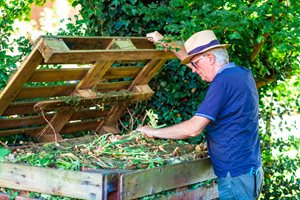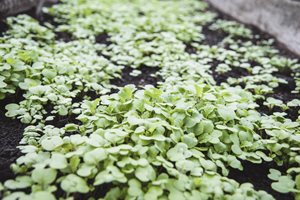Healthy soil is the heart of every thriving garden and allotment. When your soil is rich, crumbly, and full of life, plants grow stronger, crops are more productive, and your plot becomes easier to maintain year after year. Fertile soil also supports biodiversity below ground, helping your plants resist pests, diseases, and even drought.
The good news is that any soil – whether it’s heavy clay, sandy, or compacted – can be improved with time and care. With a few natural techniques and some patience, you can create soil that’s teeming with beneficial microbes and earthworms, setting the foundation for years of successful growing.
Here’s how to build and maintain healthy soil on your allotment or in your garden for years to come.
Add Organic Matter to Improve Soil

Organic matter is the secret to great soil. It feeds the living organisms within the soil — from earthworms and fungi to beneficial bacteria — all of which help to release nutrients, improve structure, and retain moisture. Whether you garden at home or on an allotment, adding compost, well-rotted manure, or leaf mould is one of the most effective ways to build fertility naturally.
Homemade compost is an excellent place to start. Made from kitchen scraps, garden clippings, grass cuttings, and shredded cardboard, it’s free, sustainable, and nutrient-rich. Well-rotted manure is another excellent soil conditioner – perfect for nutrient-hungry crops such as courgettes, potatoes, and brassicas. For gardeners working with heavy clay or sandy soil, leaf mould, created by allowing autumn leaves to break down over time, can lighten and aerate your soil beautifully.
Applying organic matter “little and often” is best. Top-dressing beds each season steadily builds structure and fertility gradually, leading to a self-sustaining ecosystem beneath your feet.
Rotate Crops to Protect Soil Health
Whether you have a small garden or a full-size allotment, rotating your crops each year prevents soil exhaustion and keeps pests and diseases at bay. Repeatedly planting the same crop family in one area drains specific nutrients and attracts recurring pests like carrot fly or clubroot.
Dividing your growing space into sections can help with the practise of rotation – For example, follow heavy feeders like potatoes or brassicas with legumes such as peas or beans, which naturally add nitrogen to the soil. Root crops like carrots and parsnips prefer lighter, less fertile soil, so plant them in beds that previously grew nutrient-hungry crops.
Even in smaller gardens, simple crop rotation in raised beds or containers can make a noticeable difference to soil quality and plant health
.
Mulch to Protect and Enrich Your Soil
Mulching is one of the easiest ways to improve soil health in both gardens and allotments. A layer of mulch placed on top of the soil helps regulate temperature, retain moisture, and suppress weeds. As it breaks down, it also adds valuable organic matter back into the soil.
You can use straw, hay, or garden compost as mulch, or even natural materials like grass cuttings, wood chips, or cardboard. Apply mulch in late spring once the soil has warmed up to trap in moisture and protect against summer heat. During winter, it also helps insulate the soil and protect beneficial organisms from frost.
Beyond its practical benefits, mulch encourages earthworms and microbes to stay active, ensuring your soil remains fertile and full of life all year round.
Encourage Soil Life and Go Easy on Digging
A thriving soil ecosystem is home to countless earthworms, beetles, fungi, and microorganisms. These living organisms are your garden’s hidden workforce – breaking down organic matter, aerating the soil, and improving structure naturally.
Avoid over-digging or rotavating too frequently, as this can disturb delicate soil structure and harm beneficial organisms. Instead, try the
no-dig method, where you add compost or organic matter on top of the soil and let worms do the work of mixing it in.
Keeping soil covered with plants, mulch, or green manures year-round also helps retain moisture and protect beneficial organisms from temperature extremes. Think of your soil as a living community – the more life it contains, the more productive and resilient it will be.
Grow Green Manures and Cover Crops

Green manures, also known as cover crops, are plants grown specifically to protect and improve soil. Sown between main crops or over winter, they prevent erosion, suppress weeds, and add organic matter when dug in or left to decompose.
Leguminous green manures like clover and vetch capture nitrogen from the air and store it in the soil, naturally enriching it for the next crop. Non-legume options such as rye or mustard are great for adding bulk and structure. When you’re ready to plant again, simply cut down the plants and leave them on the surface (“chop and drop”) or dig them lightly into the soil to decompose.
For gardeners with smaller spaces, green manures can even be grown in raised beds or large containers to give your soil a break between growing seasons – a simple and sustainable way to keep it fertile.
Protect Your Soil with a Polytunnel
Soil health doesn’t stop at the surface – it’s also about protecting your soil from the elements. Heavy rain, frost, and temperature fluctuations can leach away nutrients and damage soil structure. A polytunnel provides essential protection for your garden or allotment, shielding the soil from the elements and creating a stable, fertile environment year-round.
Inside a
Premier Polytunnel, your soil stays warmer and better drained, allowing worms and microbes to stay active throughout the year. You can continue composting, mulching, and growing even in the colder months. You can also grow green manures during winter or start early spring crops under cover, maximising productivity and protecting the soil ecosystem beneath.
For both gardens and allotments, a polytunnel is an invaluable tool – helping you grow more food, reduce waste, and safeguard your soil for future seasons.
Building Long-Term Soil Fertility
Healthy soil is the foundation of every productive garden and allotment. By adding organic matter, rotating crops, mulching, and protecting your beds with a polytunnel, you’ll create rich, living soil that rewards you with strong plants, vibrant harvests, and resilient ecosystems.
So whether you’re working a shared allotment plot or cultivating your own garden at home, remember that the key to thriving plants starts underground.
Ready to give your soil the protection it deserves? Explore our full range of
allotment and garden polytunnels and take the next step towards stronger soil, healthier crops, and bigger harvests.